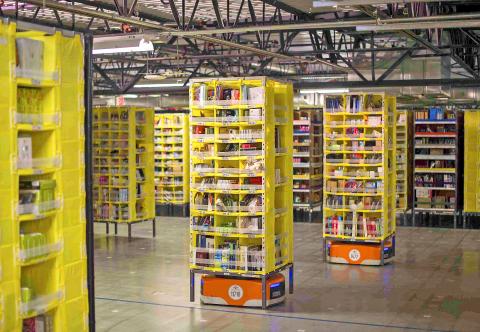A year ago, Amazon.com workers like 34-year-old Rejinaldo Rosales walked the aisles each shift to find each item a customer ordered and prepare it for shipping.
Now the e-commerce giant boasts that it has boosted efficiency by deploying more than 15,000 wheeled robots to crisscross the floors of its biggest warehouses and deliver stacks of toys, books and other products to employees.
“We pick two to three times faster than we used to,” Rosales said during a break from sorting merchandise into bins at Amazon’s massive distribution center in Tracy, California. “It’s made the job a lot easier.”

Photo: Reuters
Amazon.com Inc, which expected to face its single biggest day of online shopping yesterday, has invested heavily this year in upgrading and expanding its distribution network, adding new technology, opening more shipping centers and hiring 80,000 seasonal workers to meet the coming onslaught of holiday orders.
Amazon says it processed orders for 36.8 million items on the Monday after Thanksgiving last year, and it expected “Cyber Monday” to be even busier this year.
Chief executive Jeff Bezos vows to one day deliver packages by drone, but that technology is not ready yet. Even so, Amazon does not want a repeat of last year, when some customers were disappointed by late deliveries attributed to ice storms in the US Midwest and last-minute shipping troubles at both UPS Inc and FedEx Corp. Meanwhile, the company is facing tough competition from rivals like Google Inc and eBay Inc, and traditional retailers are offering more online services.
Amazon has forecast revenue of US$27.3 billion to US$30.3 billion for the holiday quarter, up 18 percent from last year, but less than Wall Street had expected.
However, Amazon has invested billions of US dollars in its shipping network, and its reliability is a big selling point to customers, Piper Jaffray investment analyst Gene Munster wrote in a note to clients on Friday last week. He thinks Amazon’s forecast is conservative.
The Seattle-based company now has 109 shipping centers around the globe. The Tracy facility is one of 10 in which Amazon has deployed the robots, using technology acquired when the company bought robot-maker Kiva Systems Inc in 2012, said Dave Clark, Amazon’s senior vice president for operations, who gave reporters a tour on Sunday.
More than 1,500 full-time employees work at the center. They are joined by about 3,000 robots, gliding swiftly and quietly around the warehouse. The robots navigate by scanning coded stickers on the floor, following digital commands that are beamed wirelessly from a central computer.
The system uses bar codes to track which items are on each shelf, so a robot can fetch the right shelves for each worker as orders come in.
The robots are expected to cut the Tracy center’s operating costs by 20 percent, Clark said. However, he was quick to say that they will not eliminate jobs.
“Our focus is all about building automation that helps people do their jobs better,” he said, adding that workers are needed for more complex tasks such as shelving, packing and checking for damaged items.

The US dollar was trading at NT$29.7 at 10am today on the Taipei Foreign Exchange, as the New Taiwan dollar gained NT$1.364 from the previous close last week. The NT dollar continued to rise today, after surging 3.07 percent on Friday. After opening at NT$30.91, the NT dollar gained more than NT$1 in just 15 minutes, briefly passing the NT$30 mark. Before the US Department of the Treasury's semi-annual currency report came out, expectations that the NT dollar would keep rising were already building. The NT dollar on Friday closed at NT$31.064, up by NT$0.953 — a 3.07 percent single-day gain. Today,

‘SHORT TERM’: The local currency would likely remain strong in the near term, driven by anticipated US trade pressure, capital inflows and expectations of a US Fed rate cut The US dollar is expected to fall below NT$30 in the near term, as traders anticipate increased pressure from Washington for Taiwan to allow the New Taiwan dollar to appreciate, Cathay United Bank (國泰世華銀行) chief economist Lin Chi-chao (林啟超) said. Following a sharp drop in the greenback against the NT dollar on Friday, Lin told the Central News Agency that the local currency is likely to remain strong in the short term, driven in part by market psychology surrounding anticipated US policy pressure. On Friday, the US dollar fell NT$0.953, or 3.07 percent, closing at NT$31.064 — its lowest level since Jan.

Hong Kong authorities ramped up sales of the local dollar as the greenback’s slide threatened the foreign-exchange peg. The Hong Kong Monetary Authority (HKMA) sold a record HK$60.5 billion (US$7.8 billion) of the city’s currency, according to an alert sent on its Bloomberg page yesterday in Asia, after it tested the upper end of its trading band. That added to the HK$56.1 billion of sales versus the greenback since Friday. The rapid intervention signals efforts from the city’s authorities to limit the local currency’s moves within its HK$7.75 to HK$7.85 per US dollar trading band. Heavy sales of the local dollar by

The Financial Supervisory Commission (FSC) yesterday met with some of the nation’s largest insurance companies as a skyrocketing New Taiwan dollar piles pressure on their hundreds of billions of dollars in US bond investments. The commission has asked some life insurance firms, among the biggest Asian holders of US debt, to discuss how the rapidly strengthening NT dollar has impacted their operations, people familiar with the matter said. The meeting took place as the NT dollar jumped as much as 5 percent yesterday, its biggest intraday gain in more than three decades. The local currency surged as exporters rushed to